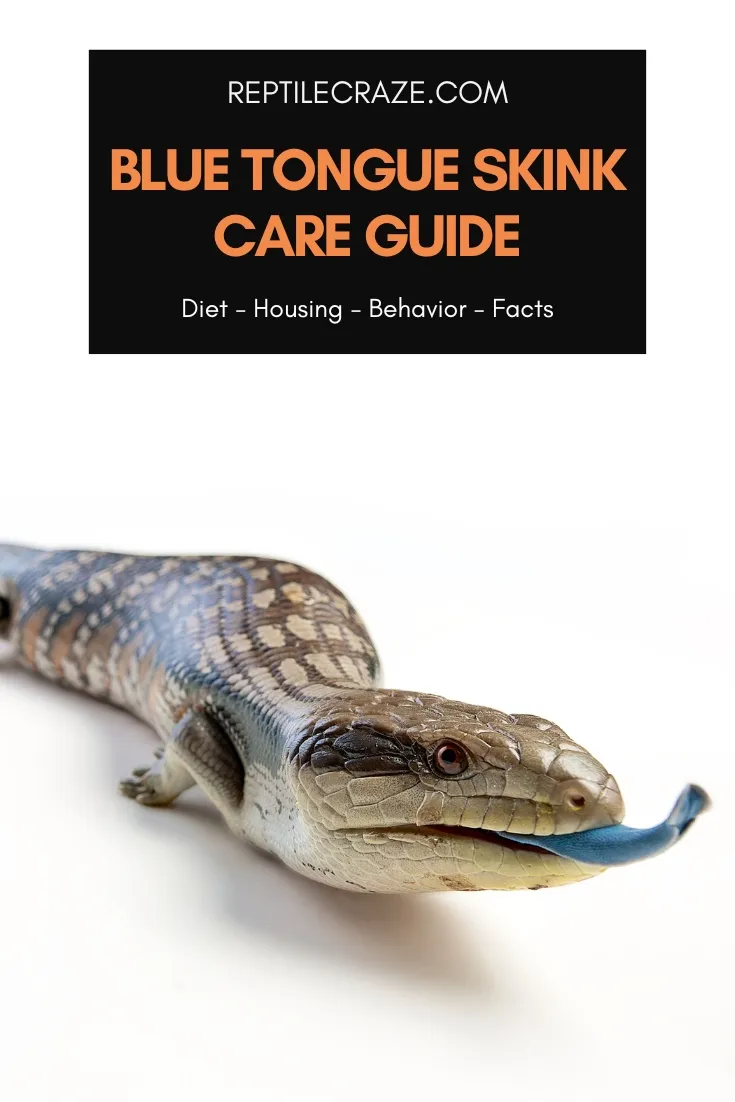
Are you thinking of getting a blue tongue skink for a pet? Perfect for novice reptile owners, these remarkable animals make outstanding pets. They are gentle and relatively easy to care for – making them the ideal pet choice.
It is essential that you properly research and prepare for their arrival before bringing a blue tongue skink home. Our care sheet will answer any questions or concerns you may have and help you properly prepare for the new arrival.
Blue Tongue Skinks – The Facts

Where Do Blue Tongue Skinks Live?
Blue tongue skinks are native to Australia. A few species and subspecies can also be found in New Guinea, Indonesia, and Tasmania.
Blue tongue skinks like to burrow for shelter and to find
Blue Tongue Skink Appearance, Colors And Morphs
There are eight different species in the genus Tiliqua, and most of these are popular choices as pets.
These skinks come in a variety of colors, from silvery-gray to yellow, brown, or black with irregularly placed dark and pale bands. Their undersides are usually a white or pale yellow color.
This skink is very well known for its long, bright blue tongue. This striking feature has led to its common name, “blue-tongue skink”.
The body of the blue tongue skink is long and tubular, with short legs and a short tail. The head is triangular and broad.
Skinks also lack the more defined neck and head found in other lizards and have thick tails, which adds to their tubular appearance.
They are often described as “a snake with legs”, as their legs are quite small in proportion to their bodies. In fact, their legs are so small that they are not very useful for walking.
Instead, the blue tongue skink will often slide on their bellies while using their stubby legs to push themselves along.
How Big Do Blue Tongue Skinks Get?
The smallest blue tongue skink species (pygmy) is only four inches long. The largest species (Merauke) tops out at about 30 inches long.
The species that are most commonly kept as pets tend to be between 17-22 inches long when mature and weigh between 10-18 ounces (283-510 g).
Blue Tongue Skink Lifespan
Blue tongue skinks are comparatively long-lived for a lizard of this size. The average lifespan is 15-20 years; however, some individuals have been reported to live for 30 years or more.
How To Care For Blue Tongue Skinks
If you’re serious about giving your blue tongue skink a long and healthy life, then understanding their needs is essential. Let’s delve deeper into what is necessary to ensure they are properly looked after.
Blue Tongue Skink Tank Setup
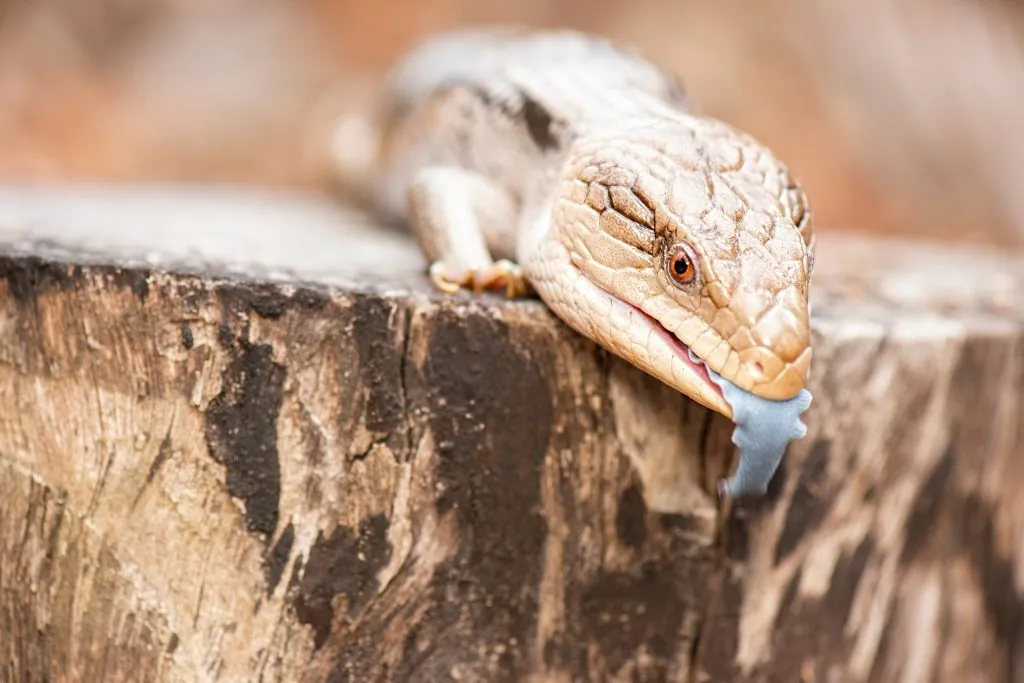
Tank Setup
When selecting a
Although hatchlings and young blue tongue skinks can reside in smaller tanks temporarily, upgrading to an adequate enclosure is essential when they mature.
Since blue tongue skinks can grow up to 22 inches, and sometimes a bit more, it is better to purchase a
A 120 gallon reptile enclosure that is 48″ x 24″ x 24″ will provide a comfortable space for your pet.
The enclosure must also have a securely fastened screened top to prevent escapes.
Lighting And Temperature
Blue tongue skinks require a temperature gradient of 65-115 °F (18-46 °C) to ensure that their body temperature stays at an optimal level.
More details on their temperature needs can be found in our Blue Tongue Skink Temperature And Humidity Guide.
Blue tongue skinks and other reptiles are cold-blooded animals, requiring external heat sources to warm their bodies. In the wild, they’d naturally get this warmth by basking in the sun’s rays.
So in captivity, it is up to you to provide your pet with an artificial light source that gives them the heat that they need.
This can be accomplished by the use of a basking lamp, such as the MCLANZOO infrared basking lamp. Most 100-150w heat bulbs will also work if paired with a good heat reflector base to maximize heat output.
Do Blue Tongue Skinks Need UVB?
Vitamin D3 is needed for calcium absorption in the body. This vitamin is produced in the skink’s skin in the presence of UVB light.
Without a good UVB light source, they will develop calcium deficiency which can be fatal if left untreated.
If you’re looking for an all-inclusive lighting solution, we highly suggest the Exo Terra Solar Glo. The Zoo Med Powersun is a good choice as well.
Both of these lights provide UVA and UVB as well as heat to meet your blue tongue skink’s needs.
Substrate
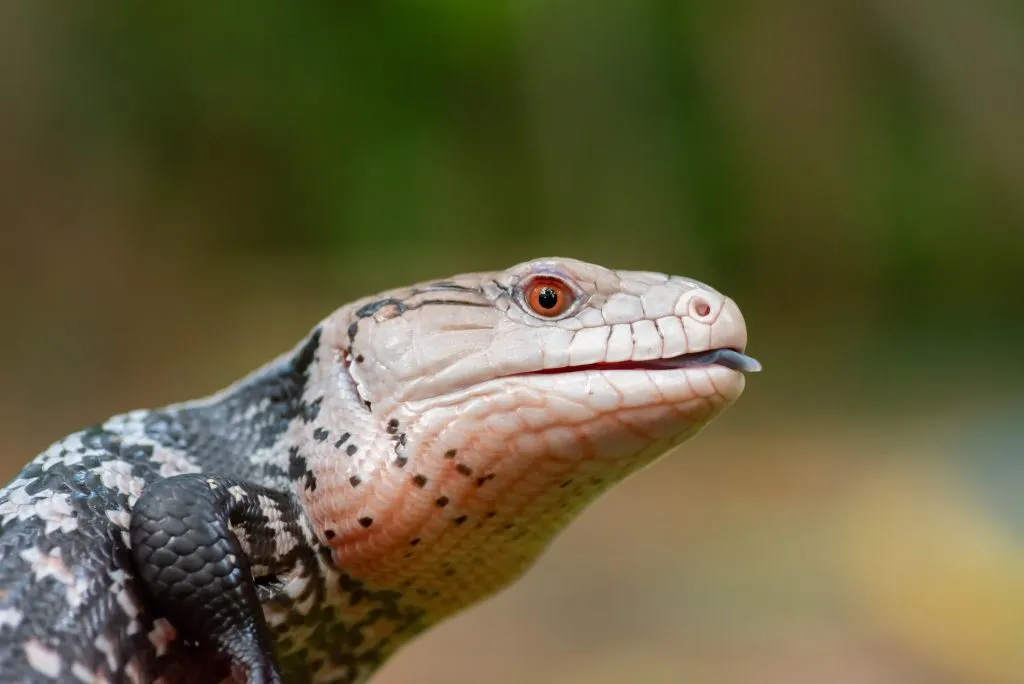
Blue tongue skinks like to dig and hide! Make sure that your
Loose, natural materials such coco husk, aspen shavings, and sphagnum moss are good substrates to use.
Substrate is also important for maintaining humidity levels in the
Tip: Read our article on substrates for blue tongue skink tanks to learn more.
Humidity
The blue tongue skink requires a specific level of humidity for optimal health.
Native Australian species require approximately 40% relative humidity to thrive, while Indonesian variants are best suited for an environment that has a relative humidity ranging between 60 and 80%.
You can read more about specific humidity requirements and how to achieve them here.
Blue Tongue Skink Tank Décor
Blue tongue skinks enjoy digging, burrowing, and exploring. It is important to incorporate the right elements into their
A water dish is, of course, a no-brainer. These reptiles should always have a dish of clean, fresh water available at all times.
Make sure it is shallow (no more than 1-2 inches deep) and stable so it doesn’t easily tip over, because your skink will eventually try to bathe in it!
A basking rock is also essential
Although blue tongue skinks are bad climbers, they will climb small structures. A large log (like this one), for example, can serve both as a climbing structure and a place to hide.
Hiding is one of the things that blue tongue skinks like to do best. If your basking rock or log furniture does not provide a hiding place already, then make sure that you get a reptile hide box (like this one) specifically for this purpose.
Plants can add interest to your skink’s habitat, but be sure to use only those than are non-toxic. There are quite a few different ones to choose from.
Tip: If you are considering adding live plants to your blue tongue skink habitat, we recommend reading our article on the subject here.
How To Clean A Blue Tongue Skink Tank
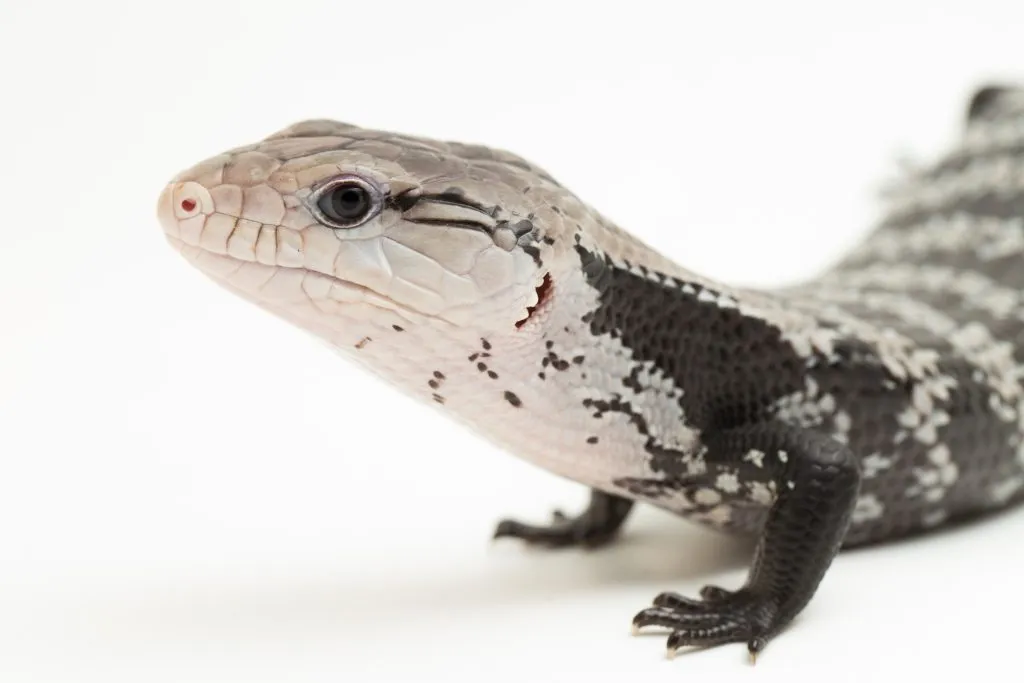
Natural substrates need only be completely changed every three or four months provided that spot-cleaning is done daily.
Remove your blue tongue skink from its enclosure before cleaning. Remove all of the furniture, dishes for
Ensure to properly clean and disinfect not only the flooring and walls but also any furnishings or dishes.
Hot soapy water can be used for cleaning, and a solution of one part bleach to 32 parts water (1/2 cup bleach to one gallon of water) can be used for disinfecting.
Rinse and dry everything thoroughly to make sure no soap or bleach residue remains.
We do not recommend trying to re-use old substrate, especially those that are natural materials such as coco fiber, wood shavings or moss.
It is difficult to clean and disinfect this material, and new substrate is usually inexpensive enough to go with new material every few months.
Blue Tongued Skink Diet
This section covers basic information on feeding blue tongue skinks. Read our blue tongue skink diet guide for more detailed information!
What To Feed
Blue-tongued skinks eat both plants and animal protein. Hatchling and juvenile diets should consist of 50% insects.
As they mature, their diet should include more plant-based foods like fruits and vegetables, especially leafy greens.
Dark, leafy greens include plants like mustard greens, kale, dandelion leaves, and endive.
Grated vegetables such as carrots and pumpkins and small pieces of squash and zucchini are also excellent additions that will provide a range of essential vitamins and minerals.
Fruit can be offered as an occasional treat, but should not make up more than 10% of the skink’s diet. Bananas, apples, mangos and berries are all good choices.
How Often To Feed
Adult blue tongue skinks do not need to be fed every day. They should be fed no more often than every other day, and in some cases less often especially if they are getting overweight.
Juveniles, on the other hand, need to eat every day.
How Long Can They Go Without Food ?
Blue tongue skinks have slow metabolisms. Not only do they not need to be fed as often as many other reptiles but they can also survive for significantly longer without
It is quite normal for adult blue tongue skinks to go several weeks without eating, or even 2-3 months if they are in brumation.
However, if lack of eating is accompanied by weight loss, lethargy, or diarrhea, then not eating may be a sign of more serious issues. If your skink is not eating and you are concerned about its health, always consult a veterinarian.
More information on possible reasons why your blue tongue skink is not eating can be found here.
Do Blue-Tongued Skinks Need Water?
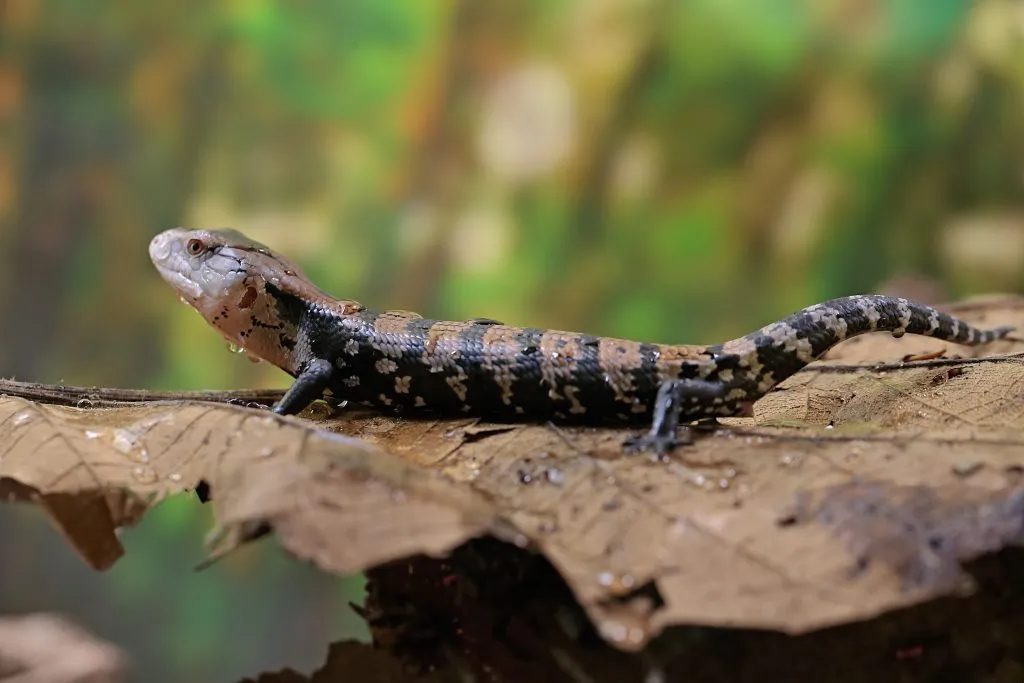
Fresh, clean water should always be available for your blue tongue skink. They do like to climb in and have a soak as well. They are not good swimmers, so be sure that the water dish is shallow so that they can climb out easily.
They are known to make a mess (yes, poop!) in the water, so make sure that you clean the water dish daily.
Vitamins and Minerals
Calcium is an essential mineral that your skink needs for a range of bodily functions and bone health, while vitamin D3 is needed to enable the body to absorb and make use of the calcium.
Your blue tongue skink will get its vitamin D3 by basking in UVB light. Calcium is provided in the diet, in particular by feeding dark leafy greens.
It is always a good idea to provide a calcium supplement as well, by dusting their
A properly balanced diet of insects, vegetables and fruit will provide most of the nutrients that your skink needs. However, if it is a picky eater, you will want to provide an appropriate vitamin/mineral supplement.
Blue-Tongued Skink Behavior and Temperament
Blue tongue skinks are generally docile and thus make great pets for first-time reptile owners. But because of their naturally shy nature, they do need to be handled regularly, otherwise, they can become skittish and nervous.
Although these animals are usually active during the day and sleep at night, they can often be found hiding during the day because hiding is just their nature.
Are Blue Tongue Skinks Good Pets For Beginners?
The blue-tongued skink is a docile, mild-mannered lizard that makes for an ideal pet. Its size, peaceful nature, and simple care requirements make it especially suitable for children or those who are new to owning reptiles.
Do Blue Tongue Skinks Like Being Handled?
Handling blue tongue skinks regularly is crucial for taming and forming a connection with their owners; failure to do this may cause them to become fearful of humans instead.
Once familiar with being handled, these animals appear to enjoy the interaction and even look forward to it.
Tip: Read this article to learn how often you should handle your blue tongue skink!
Blue Tongue Skink Common Health Problems
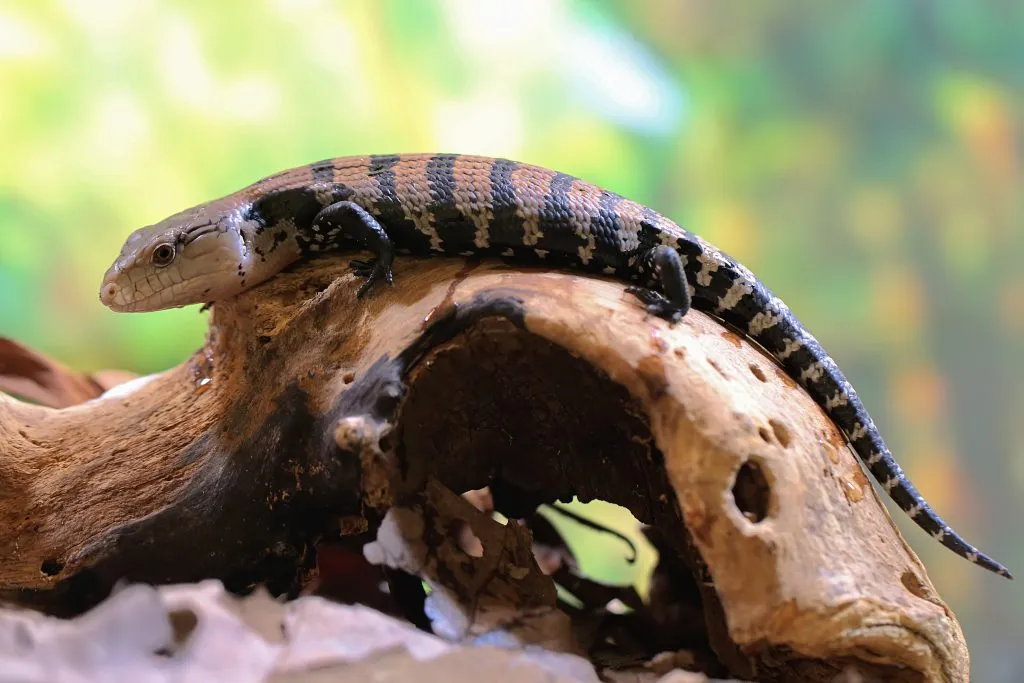
There are number of health problems that can potentially affect blue tongue skinks. The most common health issues you will encounter are:
- Hypercalcemia/metabolic bone disease (nutritional secondary hyperparathyroidism)
- Dysecdysis (retained shed)
- Stomatitis (mouth rot)
- Respiratory infections
- Parasites
Most of these health issues can be avoided by always making sure your skink is eating a well-balanced diet, is given calcium supplements regularly, and has a clean, well-designed habitat with appropriate light, humidity and temperature levels.
These health issues, and others, can be life-threatening for your pet. If you have any concerns about your blue tongue skink’s health, always consult a veterinarian for help.
Where To Buy Blue Tongue Skinks
The most reliable option is to purchase from reputable breeders. Avoid big-box stores and chain stores which typically focus on sales volume rather than quality.
To get the best possible outcome, consider finding a breeder in your area. This will allow you to view and inspect the variety of blue tongue skinks before purchase.
Skinks can also be ordered direct from breeders online, including:
- Underground Reptiles – many good reviews, and offers a wide range of pet reptiles and supplies.
- Reptile Mountain – a small-scale, professional US-based breeder specializing in Australian blue tongue skinks.
- KO Exotics – respected US-based breeder of blue tongue skinks
Blue Tongue Skink Price
If you’re looking for a common pet blue tongue species, prices begin at $150 USD for babies and increase to around $250 for adults. However, if you want something less common, be prepared to pay between $1,500 -$5,000!
Blue Tongue Skink Breeding
These reptiles do not lay eggs and, instead, give birth to live babies. Blue tongue skink babies are born fully independent and able to fend for themselves.
The mother does not take care of them after they are born, and they need to be moved to a separate
Female blue tongue skinks must be at least 24 months old to start breeding and males at least 14-18 months old. The female produces from five to 20 babies in a single litter, depending on the specific species.
Breeding blue-tongue skinks requires patience! Mating will not happen if the female is not receptive to the male, and sometimes the necessary chemistry just does not happen.
If mating does not happen after about four introductions, you may want to try introducing a different male to see if that helps the female come around.
If you are thinking about breeding blue tongue skinks, we advise researching the topic thoroughly beforehand so that everything goes as smoothly as possible.
Here’s a link to a video on the subject to help get you started:
The Final Word
Blue tongue skinks are pretty cool animals that make great pets for first-time pet owners. Caring for blue tongue skinks is, in our experience, definitely a rewarding experience.
With proper research and preparation, you will be able to provide them with an ideal environment in which they will thrive.
Blue-tongue skink ownership can be an incredibly fulfilling endeavor – one that we highly recommend taking on if possible.
- Enchi Ball Python: A Unique and Stunning Morph of Python regius - March 27, 2025
- Emerald Tree Monitor: The Enigmatic Green Guardian of the Rainforest - March 26, 2025
- The Egyptian Cobra (Naja haje): A Fascinating Serpent - March 25, 2025
